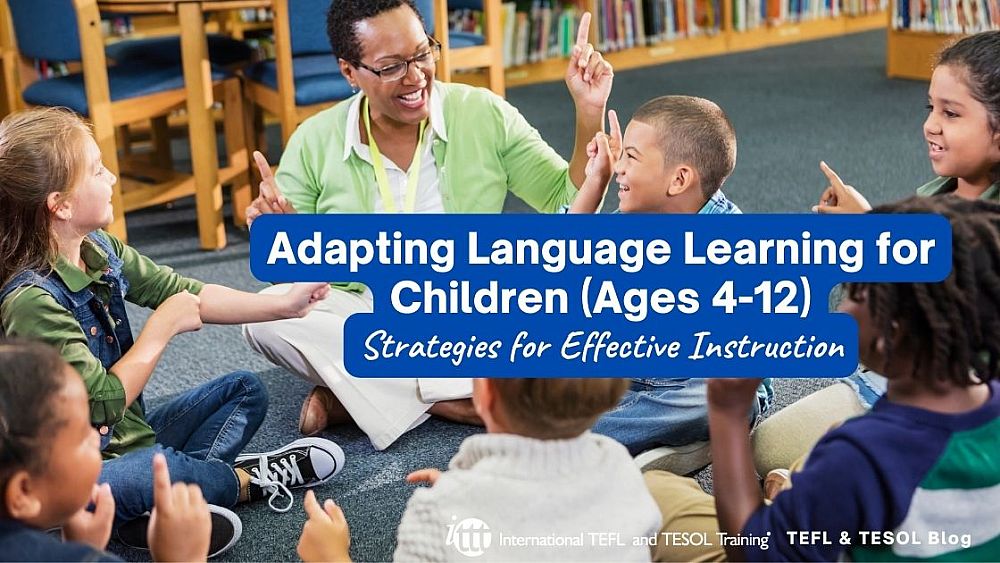Adapting Language Learning for Children (Ages 4-12): Strategies for Effective Instruction

Embark on a journey through the fascinating world of language learning for children between the ages of 4 and 12. Delve into the developmental nuances of preschoolers and school-age/pre-puberty learners, while uncovering a treasure trove of effective teaching approaches. Whether you're an educator, parent, or language enthusiast, this article offers valuable insights and practical strategies to ignite young minds and unleash the full potential of language acquisition at each stage.
Table of Contents
Preschoolers (Ages 4-6): Fostering Creativity and Imagination
School-Age/Pre-Puberty Learners (Ages 6-12): Developing Language Proficiency
Tailoring Instruction for Success
Are you ready to teach English as a foreign language?
Check out what our course grads say in our many video testimonials!
Disclaimer: The views and opinions expressed in this blog post are solely those of the author, an alumni of ITTT (International TEFL and TESOL Training). They do not necessarily reflect the views or opinions of ITTT. The content provided in this post is for informational purposes only and should not be considered as official endorsement or representation by ITTT.
Preschoolers (Ages 4-6): Fostering Creativity and Imagination
During the preschool years, children between the ages of 4 and 6 experience significant cognitive and motoric development. Their thinking and memory processes become faster and more efficient, while their left and right brain hemispheres become more connected. Drawing plays a crucial role in motor skill development, cognitive growth, and fostering creativity.
Stimulating Creativity: Drawing stimulates motor skills, cognitive abilities, and imagination. Encourage preschoolers to express themselves through drawing and utilize their artwork as a springboard for language learning. Connect words and concepts to their drawings, gradually expanding their vocabulary.
Developing Memory: Preschoolers exhibit improvements in their memory compared to toddlers, although memory skills are still developing. They tend to remember simple pictures and scripts better than memory tests. Use motivation, concentration, and age-appropriate memory strategies to support their learning process.
Engaging through Games and Role-plays: Games are highly effective in capturing preschoolers' attention and enhancing their language skills. Incorporate role-plays and interactive activities that align with their interests and foster their imagination. Fairytales are particularly engaging, as they offer a magical and safe world for exploration.
School-Age/Pre-Puberty Learners (Ages 6-12): Developing Language Proficiency
As children progress into the school-age years (6-12), their cognitive abilities continue to evolve. They demonstrate improved writing, drawing, and perspective-taking skills. Understanding their developmental milestones helps create effective language learning environments.
Emphasizing Repetition and Context: School-age/pre-puberty learners benefit from regular repetition to reinforce language learning. As their vocabulary expands, they extract meaning from new words through contextual cues. Utilize various learning materials that cater to their interests, allowing them to connect with the language on a personal level.
Encouraging Problem-Solving and Coping Mechanisms: Incorporate problem-solving activities that promote critical thinking and independent learning. Teach coping mechanisms to help them navigate challenges encountered during the language learning process.
Leveraging Emotional Awareness: At this stage, children experience multiple emotions simultaneously and gradually develop empathy. Capitalize on their expanding emotional intelligence by incorporating emotional themes into language lessons. This facilitates deeper connections with the language and enhances their communication skills.
Tailoring Instruction for Success
Understanding the unique characteristics and developmental needs of children between the ages of 4 and 12 is essential for effective language instruction. By fostering creativity, engaging through games and role-plays, emphasizing repetition and context, promoting problem-solving, and leveraging emotional awareness, educators can create dynamic learning environments that facilitate language acquisition and nurture a lifelong love for learning.
Are you ready to teach English as a foreign language?
Apply now & get certified to teach english abroad!
Speak with an ITTT advisor today to put together your personal plan for teaching English abroad!
Send us an email or call us toll-free at 1-800-490-0531 to speak with an ITTT advisor today.
Related Articles:
- Top 10 Cities in Europe with the Highest Demand for English Language Teachers
- 5 Reasons To Take A TEFL Course Right Now - Even If You Are Not Leaving Yet | ITTT | TEFL Blog
- All the Documents You Will Need to Teach English Abroad
- The Impact of Positive Motivation on an ESL Classroom
- You're Never Too Old to Change Your Life and Do a TEFL Course | ITTT | TEFL Blog
- Getting Student Placement Right - The Best Desk Arrangements for EFL Students



